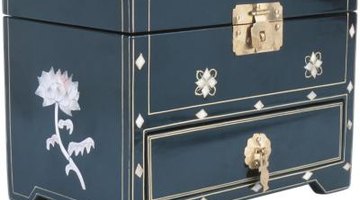How to Restore Lacquer on a Japanese Jewelry Box
Lacquer is made from the sap harvested from trees related to sumac and poison ivy. It is applied in thin layers, up to 100 or more, making a durable surface. Lacquer is cured in high humidity, and should be maintained in an area with level humidity, as changes in humidity can cause the lacquer to crack. Some items that look lacquered may actually be finished with shellac. It's important to determine what the finish actually is before attempting to restore the finish.

Step 1
Clean the finish with a mild oil soap. If this doesn't clean the object enough, use mineral spirits or a citrus-based cleaner. Rub the surface gently with a soft cloth and the solvent or cleaner you are using. Keep turning the cloth until you don't pick up any more dirt. Wipe the surface with a clean soft cloth after cleaning it.
Step 2
Test a hidden area with a cotton-tipped swab dipped in alcohol. If alcohol softens the finish, it is probably shellac. If alcohol doesn't have any effect, test the area with a cotton-tipped swab saturated with lacquer thinner. If the finish turns rough and then smooths out again, it is lacquer. Once you have identified the finish, you can proceed to restore it.
Step 3
Apply the solvent with a brush, using quick, long strokes. Use lacquer thinner to reamalgamate lacquer, and use alcohol to reamalgamate a shellac finish. Work quickly, keeping the brush wet, so that you don't start to remove the finish instead of just softening it. Don't try to brush out all the imperfections. It's enough to soften the finish. It will smooth out as the solvent dries. Let the solvent dry until it is no longer tacky. Allow four or five hours for the finish to completely dry.
Step 4
Wax the surface once it is dry. After using the solvent to smooth the finish, it will look dry. Apply a layer of furniture wax and buff it to a high shine using a soft cloth.
References
Resources
- The Furniture Doctor; George Grotz
Writer Bio
Ramona French owned a massage school and taught massage for 28 years. In that time she wrote textbooks on Swedish, acupressure, deep tissue and lymph drainage massage. She is the author of "Introduction to Lymph Drainage Massage" and "Milady's Guide to Lymph Drainage Massage." Her book, "The Complete Guide to Lymph Drainage Massage," published by Milady, was released in October 2011.
Photo Credits
- Hemera Technologies/PhotoObjects.net/Getty Images
More Articles



